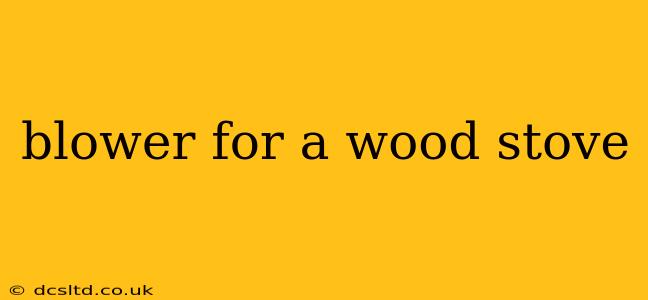Choosing the right blower for your wood stove can significantly improve efficiency and comfort. A well-chosen blower circulates warm air throughout your home, maximizing the heat output of your stove and minimizing the need to constantly adjust the damper. However, with a variety of options available, selecting the perfect blower can feel overwhelming. This guide will walk you through the key considerations, answering common questions to help you make an informed decision.
What are the Benefits of Using a Wood Stove Blower?
A wood stove blower offers numerous advantages:
-
Improved Heat Distribution: A blower effectively circulates warm air from the stove to all corners of the room, ensuring even heating and eliminating cold spots. This is especially beneficial in larger spaces where the stove's natural convection isn't sufficient.
-
Increased Efficiency: By improving heat distribution, a blower helps you extract more heat from your wood stove, meaning you can use less wood to achieve the same level of warmth. This translates to cost savings and reduced environmental impact.
-
Enhanced Comfort: Instead of being confined to the immediate vicinity of the stove, you can enjoy consistent warmth throughout the room or even multiple rooms, leading to a more comfortable and enjoyable heating experience.
What Types of Wood Stove Blowers are Available?
There are several types of blowers designed for wood stoves:
-
Electric Blowers: These are the most common type, powered by a standard electrical outlet. They're relatively inexpensive, easy to install, and offer various speed settings for customized airflow.
-
Battery-Powered Blowers: These offer the advantage of portability and can be used even in areas without electrical outlets. However, they may have shorter runtimes and require regular battery replacement or charging.
-
Thermostatic Blowers: These advanced models include a thermostat that automatically adjusts the blower speed based on the temperature near the stove. This feature optimizes efficiency and prevents overheating.
How Do I Choose the Right Size Blower for My Wood Stove?
Choosing the correct size blower is crucial. Too small a blower won't adequately circulate the heat, while too large a blower could be noisy and inefficient. Consider these factors:
-
Stove Size and Output: Larger stoves require blowers with higher CFM (cubic feet per minute) ratings. Check your stove's specifications for its heat output to guide your blower selection.
-
Room Size: The larger the room, the higher the CFM rating you'll likely need. Consider the volume of the area you want to heat.
-
Insulation Level of Your Home: Better-insulated homes will require less powerful blowers to achieve the desired warmth.
How Much Does a Wood Stove Blower Cost?
The cost of a wood stove blower varies depending on the type, features, and brand. You can expect to find options ranging from budget-friendly models under $50 to more advanced thermostatic blowers costing several hundred dollars.
How Do I Install a Wood Stove Blower?
Installation typically involves attaching the blower to the stovepipe using clamps or other mounting hardware. Always consult the manufacturer's instructions for your specific blower model. Safety is paramount, so ensure the blower is properly installed and securely fastened to prevent fire hazards.
Can I Use a Wood Stove Blower with Any Type of Stove?
While most blowers are compatible with various wood stove types, it's essential to check the blower's specifications and ensure compatibility with your stove's dimensions and design. Pay particular attention to the size and shape of your stovepipe. Some stoves may have specific blower recommendations.
Are Wood Stove Blowers Safe?
Wood stove blowers are generally safe when properly installed and used according to the manufacturer's instructions. Always ensure the blower is adequately ventilated, and regularly inspect for any signs of damage or overheating. Never leave a running blower unattended.
What are the Potential Problems with Wood Stove Blowers?
Potential issues can include:
-
Overheating: Improper installation or a malfunctioning thermostat can lead to overheating.
-
Noise: Some blowers can be quite noisy, especially at higher speeds.
-
Power Outages: Electric blowers are reliant on a continuous power supply. Battery-powered options offer a solution in the event of power failure.
By considering these factors and carefully researching different models, you can select the perfect blower to optimize your wood stove's performance and enjoy a warmer, more comfortable home. Remember to always prioritize safety and consult professional advice if needed.
